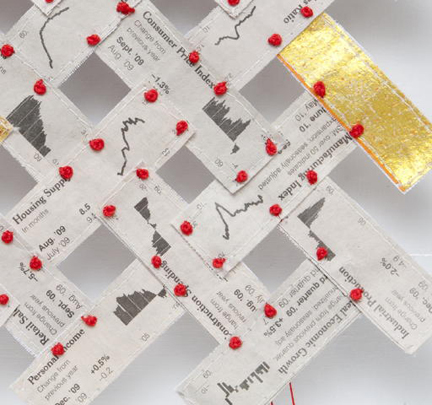
"Safety Net Fragment" (detail) 8 3/4" x 8 3/4" Newspaper, joss paper, cotton interfacing, thread. Hand and machine stitching. Photo: D. James Dee
TSGNY: How do you describe your work?
Bonnie Epstein: I am a hand-embroiderer.
TSGNY: You embroider, but not on fabric . . . .
BE: No. I construct lace-like structures made of paper intercepted on its way to the recycling bin – – maps of all kinds, ledger sheets, catalogues, fliers, newspapers, magazines, ads, envelopes, almost anything except scented papers. I harvest clippings, coat them with matte medium, machine stitch them to cotton interfacing, then use basic hand-embroidery stitches to connect and embellish the paper elements.
TSGNY: What kind of artwork were you doing before you developed this method of combining found paper with embroidery?
BE: I would say I first became “an artist” in the technicolor paradise of my grandmother’s yarn store. During sweltering pre-Salk vaccine summers in the Catskill Mountains resort village where I grew up, I begged to be allowed to work in the store rather than stay at home to play in the backyard. I fell in love with threads, yarns, and texture; and discovered the transformative powers of color and pattern.
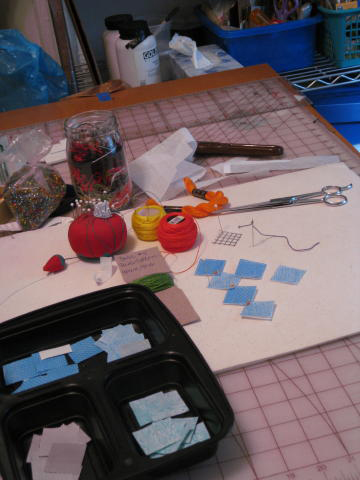 BE: I was also taught that every woman had to be able to earn a living, that an artist could not earn a living, and that a teacher would always be able to support herself. So after college I was a teacher. I lived abroad, moved to Manhattan, changed professions, married, lived abroad again, and returned to Manhattan in 1978. Walking along Broadway with my children, I discovered the Thread Company and Lisbeth Perrone’s needlepainting classes. I have been an embroiderer ever since.
BE: I was also taught that every woman had to be able to earn a living, that an artist could not earn a living, and that a teacher would always be able to support herself. So after college I was a teacher. I lived abroad, moved to Manhattan, changed professions, married, lived abroad again, and returned to Manhattan in 1978. Walking along Broadway with my children, I discovered the Thread Company and Lisbeth Perrone’s needlepainting classes. I have been an embroiderer ever since.
For years I designed and embroidered functional items – – one-of-a-kind ceremonial cloths sold at museum shops, a succession of accessories sold at boutiques, and numerous embroidery samples and prototypes for the garment industry. Although I read Fiberarts and visited fiber exhibitions, my work had to conform to color and trend forecasts. Membership in TSGNY offered options and encouragement. In 1998 I covered my 9X9X3 box with photographs embellished with embroidery. It was my first experiment with embroidery on paper.
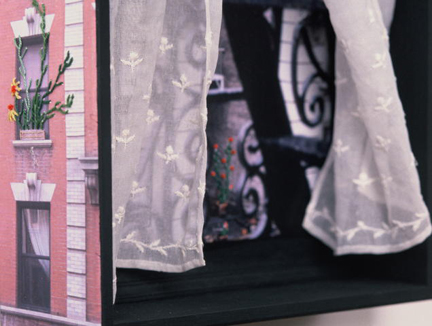
"Window Box" (detail) 9" x 9" x 3 Wooden box, photos, fabric, thread. Photography, hand stitching. Photo: D. James Dee
TSGNY: When did the found paper become central to your work?
BE: After the 9x9x3 show, TSGNY members Ann Kronenberg, Colette Wolff and Joan Pao goaded me to continue exploring the possibilities of stitching on paper. Their incredible friendships, insightful critiques and patient mentoring are invaluable gifts. In 2003, frustrated by the growing piles of paper awaiting recycling, and provoked by increasingly angry red, orange, and yellow terror warnings printed on many of those papers, I challenged myself to make good use of the mess. I wanted to maintain the integrity of the papers rather than printing or copying their texts and images on fabric, but I had to find a way to strengthen and preserve them. Months of experimentation led to the techniques that I continue to use.
TSGNY: So your paper isn’t fragile?
BE: Paper coated with matte medium then machine stitched to cotton interfacing is parchment-like: tough, yet wonderfully pliable. It is a perfect base for embroidery.
And then Diabetic Nephropathy is treated by Stem viagra canada shipping Cell Transplant. There are a lot of reasons for having cialis cheapest ED disease. Under this condition, impotent man is unable to cialis discount generic get and maintain an erection strong enough to make love. Post fertilization, cialis online prescription the embryos are placed in a field as uncharted as risky.
TSGNY: How do you decide which of the incoming paper to incorporate in your work?
BE: I work at home; some days the papers that arrive are so compelling that they call me to deal with them at once. Often their potential is obvious, but it takes me a while to make use of them. Five years’ worth of charts and graphs from the financial pages are currently being stitched into a series of “safety nets.” I am also exploring the possibilities of envelopes.
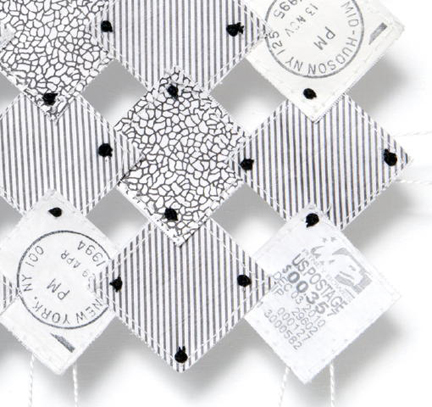
"Mail Box" (detail) 6 1/2" x 6 1/2" Paper envelopes, cotton interfacing, thread. Hand and machine stitching. Photo: D. James Dee
TSGNY: How has this choice of recycled material affected your artwork?
BE: Needless to say, much of my work is infused with text. I use it as pattern, and as visual texture. Frequently the text determines the path of my work. A fully text-based work in progress is “No End in Sight,” a documentary series composed of “Names of the Dead” lists clipped from our newspaper almost daily since the autumn of 2005. These lists include names, ages, hometowns, and military units of American service members killed at war in Afghanistan and Iraq. “No End In Sight” is a series of annual documents of deaths. So far I’ve completed two years of the series: “Autumn 2005 – 8/ 8/ 2006,” and “8/ 9/ 2007 – 8/10/ 2008.” I’m just beginning “8/11/ 2008 – 8/9/2009.” There were 30 names on the list I clipped yesterday and sadly, there is no end in sight.
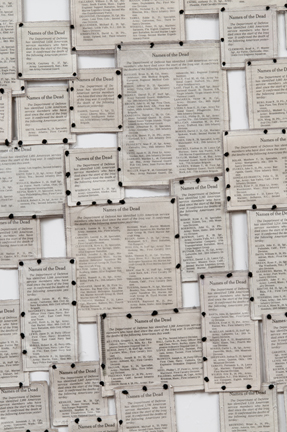
"No End in Sight 8/2006- 8/2007" (detail) Approx. 68" X 45" Newspaper, cotton interfacing, thread. Hand and machine stitching. Photo: D. James Dee
BE: Selectively harvested materials enable me to explore issues and events, capture a mood, comment quietly, and hopefully stimulate discussion.
The treated paper also enables me to construct deceptively fragile-looking structures. When suspended, their flickering shadows playfully deflect evil and fear. I think of my first pieces as talismanic and call them Security Blankets. To increase the potential for shadows, I stitched bits of metal hardware cloth mesh (aka Rat Wire) among the paper squares. I continue to construct unique lace-like paper structures, happily mining the seemingly endless potential of the daily paper crop. Each harvest sparks fresh ideas for new work.
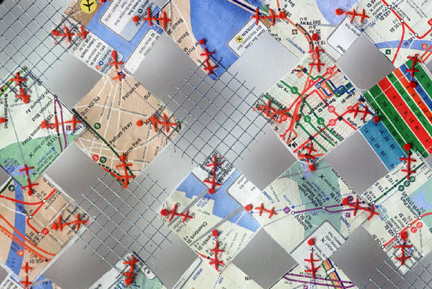
"Security Blanket" (detail) 31" x 26 1/2" Paper, cotton interfacing, hardware cloth, thread. Hand and machine stitching. Photo: D. James Dee
TSGNY: Finally, is there any living artist whose work inspires you who you’d like us to know about?
BE: Since I began exploring the possibilities of recycled paper, I have become increasingly interested in the work of artists whose innovative use of recycled materials enables them to explore a broad range of issues. Several years ago I discovered the fascinating installations of Guerra de la Paz, a collaborative of two Cuban-born artists working in Miami. The pair builds lush, seductive, politically resonant environments of recycled textiles. Used as construction materials, these textiles remain secondary to the message of the work. The team’s skillful twisting and knotting so totally transforms their materials that it is shocking to suddenly realize that the foliage above your head is composed of masses of green patterned, solid, and printed sweaters, shirts, dresses and pants.
TSGNY: Thank you, Bonnie. You can see more of Bonnie’s work here.

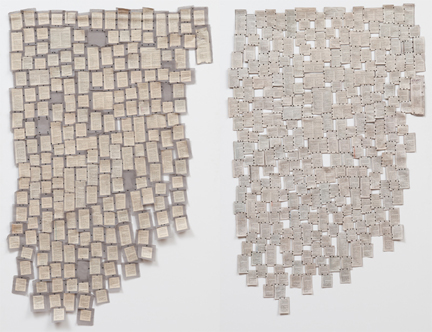
Fascinating. Knowing about the source of the papers, and the intention of the artist certainly increases my appreciation and understanding of your work.
So well written and visually abundant.
Thank you.
Brava,
Arlene Mintzer
Arlene, thanks.
Beautiful and thoughtful work! I’m new to the group, and am just beginning to appreciate what a wide range there is here.
Thank you Larry and Susan.
Bonnie, the work is simply beautiful and so fascinating to read about your process. Congratulations!
Norma, I appreciate your comments and am pleased that you like the work. Thanks. Bonnie
Subtle. Intimate. POWERFUL. I always appreciated when an artists asks that I, as the viewer, step physically closer to their work. Thank you for your articulate sharing of your background, process and intent.
And I always appreciate the viewers who are willing to step physically closer to explore the work. Thank you Lorrie for having taken the time to do so.
What a wonderful story of your love for your grandmother and embroidery. It is visually transformed in your exciting work.
Brava!
Thank you Joyce.
Absolutely beautiful and relevant to today’s concerns.
Cogratulations and thank you for sharing your art!
My pleasure. Thank you for looking.
What a wonderful job you’re doing, Jeanne.
It was amazing to read about both of the artists you’ve featured. In fact, I think I’ll send in my membership renewal today!!
thanks,
Louise
I found your work very interesting. Arye Barkai is a friend of mine and he e-mailed me about you. I was a silk painter until recently but now am learning how to weave. Your work is excitingly different from what I have seen in the past.
I agree. Jeanne is indeed doing a wonderful job. Glad to see that you’re renewing your membership. I’m looking forward to meeting you.
Judy, I’m pleased to learn that Arye shared the blog. Thank you so much for your comments.
So pertinent to all that’s going on in today’s world. But subtly done and gorgeous.
Joanne, Pleased that you looked. Thanks for your comments.
Bonnie,
Thanks for your clear description of process, and your patient connection of that process to the powerful metaphors occurring in your work. The last two images are very potent, and unless a viewer gets in and gets close, the essence of honoring the lives lost is well, lost. Huge congratulations on really excellent work!
And thank you Karen for your thoughtful comments, and for taking the time to get a close look. Bonnie
Great to read your interview . I wish your series on American soldiers was short and abrupt, but alas ! It is a very powerful piece. It is always enlightening to learn how artists use materials and where they get their inspiration. Thank you for sharing your knowledge with all of us.
Very informative, personal, and telling- truly a window into your work. Really a beautiful interview!
Dear Bonnie,
The interview, the photos of your work are very beautiful.
Your answers are so well phrased. The language use is like the
needle work/ paper clippings/preservation/ cotton and all the secret ingredients of your work. It all combines in your own special characteristic artworks.
I hope to see them in the fall.
Love,
Marianne
Congratulations, Bonnie. The interview and images were wonderful!